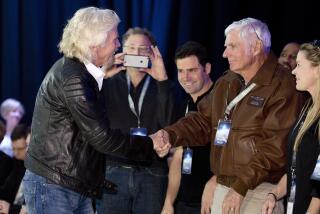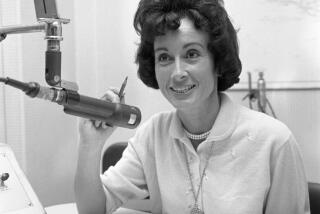Pioneer of Flight Lends Expo an Air of History
CARLSBAD — Pioneer aviator Evelyn “Bobbi” Trout learned to fly “out in the sticks,” soaring over apricot trees and walnut groves in a sparsely populated land with few houses.
It was the late 1920’s, and that land was the San Fernando Valley around what is now Van Nuys Airport--then known as Los Angeles Municipal Airport.
The Van Nuys Airport Aviation Expo next weekend will pay tribute to Trout, 93, one of the most prominent women in aviation history.
“All women in aviation, myself included, owe Bobbi a debt of gratitude,” said Debbie Harvey, a former commercial airline pilot and a professor at Embry-Riddle Aeronautical University in Prescott, Ariz. “She opened a lot of doors and we can have pink skies and tail winds because of her.”
In what she predicts will be her final public appearance, Trout will return to those same “sticks” to mark the 70th anniversary of a series of flying records she set in 1929, including several at Van Nuys.
From an air-conditioned trailer to be supplied by friends and supporters, Trout expects to sign autographs and regale visitors to the two-day show with stories of her early flying adventures.
The show is scheduled Saturday and Sunday from 9 a.m. to 5 p.m. Trout will be honored at opening ceremonies at 10 a.m. Saturday.
“When you get to be my age,” said Trout, the fifth woman to earn a transport pilot’s license, “you remember things from long ago better than you do yesterday.”
And vivid her memory is, scented with the aroma of lemon blossoms wafting from Valley orchards and painted with the hues of sunset on her first record-setting endurance of flight.
Sitting in her retirement condominium in this seaside resort community, surrounded by mementos of a career she gave up more than a half century ago, Bobbi, as everyone calls her, can tell stories about the stories in history books.
One flier, she said, pointing a gnarled finger to a page in an aviation journal, was never a member of a famed aerobatic team as the book reports. “She was such a pain to deal with, [the instructor] said he would never attempt to teach another woman to fly.”
Another, she remarked while turning the pages, won a title by default, because her supportive competitors knew she needed the fame and fortune for her livelihood.
Still flipping through the book, Trout stopped at the name of another pioneer, offering an aside. This one, she said, along with a passenger, fell to their deaths when an airplane in which they were not strapped in took an unexpected roll.
Names such as Amelia Earhart (envied for her wealthy backers, Trout says), Orville Wright (who signed her pilot’s license) and Charles Lindbergh roll out of Trout’s memory bank as if she had met with them yesterday.
Trout is the sole survivor of the original Powder Puff Derby, held in 1929, in which 20 women pilots undertook a grueling eight-day, cross-country trip from Santa Monica to Cleveland. Fourteen completed the trip, including Trout, though she had four major setbacks along the way and arrived just before the final celebration dinner.
Trout admits there is some fiction in her 1987 biography, “Just Plane Crazy,” but she said friends say the embellishments make the story more interesting.
Born Jan. 7, 1906, in Greenup, Ill., Trout spent much of her childhood moving with her family around the country, staying with various relatives.
“Mother wanted me to have an education and Dad wanted me to travel all over,” she said.
Trout was living in Seattle during World War I when she studied a manual of firearms and mastered a .22-caliber rifle. She was in a field shooting one day when she looked up at the sound of an engine overhead.
“Ohh,” Trout sighed, clasping hands over her heart, lifting eyes toward the ceiling. “Over went an airplane. I said, ‘That’s what I’m going to do some day.’ I just knew it.”
The family settled in Southern California in 1920. Trout remembers trying to get into manual arts training courses “with the boys”.
“But school officials wouldn’t let me,” she said. “Instead, I had to make hamburgers. Boy, did that ruin my feelings, having to take a sissy course like cooking. That broke my heart.”
She as a student at Lincoln High School in Los Angeles when she persuaded her parents to buy a service station for her to run. “I always did fine with mechanics. I was good at taking things apart and putting them back together again.”
Soon, she said, the service station was doing so well that her father had to quit his job with the telephone company to help run the business.
At age 21, Trout was earning enough money to afford flying lessons. With great detail, she described her first crash.
She disobeyed an instructor’s orders to make a turn because she said she feared the plane was flying too low. The instructor took the controls to demonstrate and immediately crashed, knocking both of them unconscious upon impact. Trout pointed to her cheek where she suffered a cut from her goggles.
“I was told there were two little kids there who saw it happen. When they saw our faces,” Trout demonstrated by leaning limply forward, “the kids ran like scared rabbits.” She laughed heartily, visualizing the panic.
Working as a demonstration pilot for an airplane manufacturer, Trout flew out of airports throughout Southern California, including Mines Field in Westchester, now Los Angeles International Airport, Los Angeles Municipal and Grand Central in Glendale.
Two hard landings are among her vivid recollections of the first women’s derby. She bluntly admits she ran out of gas while flying low over Mexico on one leg of the trip. “When you fly low, you get better air speed.”
She set the plane down in a newly harrowed field, but suddenly found herself bouncing through deep ruts that flipped the plane. “It must have been dug by the biggest tractor in the world.”
Her engine died 70 miles short of Cleveland. The plane ground-looped as she landed near a farmhouse, ripping a wing on a fence post. She fashioned her own repairs, using “old tin and bailing wire,” a solution that prompted a scolding from federal aviation officials when she reached her destination. “I told them, ‘It got me here all right, didn’t it?”
Trout remembers Mines Field as having “only one building on the south side of the airport. The building, she said, was the size of a double garage and made of corrugated aluminum.” She chuckles when she talks about the family passing up buying land in the Valley that was priced at $250 an acre. “We thought we’d all be dead before it was worth anything.”
“Oh, honey, I have pictures of that,” she said, pointing to her head as she described another harrowing experience in which a parachute caught in the tail of her airplane.
“She is always a draw, she has such good stories to tell,” said Peggy Baty, president and founder of Women in Aviation, International, based in West Alexandria, Ohio.
Describing Trout as “a role model in aviation,” Baty said Trout “set a number of speed records and endurance records in the ‘20s and ‘30s, not just competing with women, but with pilots in general.”
Trout, who never married, said she got the flying frenzy out of her blood by the mid-1940s. She started several successful aviation-related businesses to aid war efforts, including inventing a machine to sort rivets and another to de-burr airplane parts.
She manufactured refrigerator egg-storage baskets and fashioned a remote-control device to adjust automobile side-view mirrors.
“I lost $25,000 on that one,” she lamented, because no one would purchase a device that required them to drill a hole into the vehicle.
She sold real estate, life annuities and mutual funds in the Palm Springs area for 20 years until she retired in 1976, settling into her condo and driving a red Porsche 914. The car has sat unused in her garage for a year, not because of the owner’s age, but because it quit. Trout still drives around town in a used Acura and to the local airport for flying trips with friends, most of whom are pilots.
She stays busy with a promotional Internet site and by writing and reading. “Most of my old friends are gone,” she added wistfully. “It’s just terrible. They are long gone.”
But a smile brightened her face as she gazed out the window at a tiny lemon tree. Clearly, memories awakened.
More to Read
Sign up for The Wild
We’ll help you find the best places to hike, bike and run, as well as the perfect silent spots for meditation and yoga.
You may occasionally receive promotional content from the Los Angeles Times.






